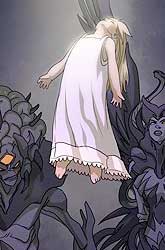Two Webcomics, Two Standards

Got two emails in the last few days with links to two new webcomics using navigation techniques that neatly sum up this interesting technological moment we’re in.
Turbo Defiant Kimecan by Mexican artist Ferran Daniel uses Flash to load one panel or element at a time. We’ve seen a few comics like it, but this one gets points for some pretty artwork. Curious to hear what people think of this sort of loading order, now that we’ve seen it a few times. (Maybe time to revisit this discussion?)
Meanwhile, along comes an HTML 5 comic, Never Mind the Bullets (cooked up by Steaw Web Design to show off Microsoft’s IE9). More proof-of-concept than anything else, but it’s kind of cool and got me thinking about how that layered effect could be used in other ways. (thanks again to Randy Oest for the tip).
Of course, the real shoot-out going on this year is between file formats, and with the recent back-and-forth in the mobile space over Flash and HTML 5, it’s helpful to have some concrete reminders of the very different creative directions each might take us in.
Impressions?
[Edit to Add: Since both are getting a sound beating in the comments section, I should probably make it clear that neither comic represent more than a tiny fraction of what can be (or has been) done with either Flash or HTML 5, and I’m not endorsing either approach as “the future of comics” or anything. But it’s always interesting to see how many different reading models there are, and even failed attempts can sometimes contain useful ideas.]















Hi,
I only tried to read through around 10 “screens” of each and both make me think that the approach is naive.
First, Turbo Defiant Kimecan uses spawning panels in positions that are typic of paper comics. In a non-paper comics, it looks just wrong as there is no exploitation of the “free” overlapping space. I mean that a lot of those spawning should have exploited the fact that at each new screen, the whole canvas can be used, not juste the “blank space”.
Next Never Mind the Bullets, they forgot the basic thing about reading comics (whatever the form) that we know in the video game world : navigation is hard. Each time you make the player have to navigate non-easily, you make reading harder than it should. That’s also why the infinite canvas is hard to make right without automatic positionning of the camera.
Anyway, those are still interesting experiments. It helps points what basic fundamental “rules” (that by definition can be broken if necessary) might be useful to know when creating “digital comics” (or whatever name will stand in the end).
“Never Mind the Bullets” was impossible to read. It was just so slow. It felt like I was on dial up. Was the characters and elements sliding around all it did? Was THAT the point?
I wonder how much HTML 5 needs a screaming fast machine and full open internet connection. The technical issues negated the story.
It could well be your browser. Chrome and Opera have vastly faster Javascript then Firefox3. Try again at Firefox4 beta, or switch your browser.
(IE, likewise, is painfully slow at javascript).
@John; As a web designer/developer (who is partial to HTML5) I can tell you with some certainty that it is not the format that made “Never Mind the Bullets” slow, it was all of the layered images, which would make Flash slow as well (though it would just load it all up front as they are wont to do).
My main issue with each is that if you make it move (even a little), aren’t you negating some of the imagination involved in letting the reader bring the world alive? I found myself marveling more at the effects and forgot the story.
Never Mind the Bullets – I had to install IE9 to view at the right speed, as it played very poorly on android phone and a pc version of Chrome. But really, it was awful. Terrible parallax motion. If you’re going to showcase HTML5 capabilities, try optimising it to work across many browsers and devices – surely the whole point of HTML5. Don’t suppose there are many iPad users out there running IE9.
Darn, I almost feel sorry for the creators of Never Mind the Bullets. They seem to have spent so much time in their project, but it’s absolutely unreadable. It was an excruciating experience just to reach panel 3.
Now, i don’t think this two examples really say anything about the web standard used. You could easily do something like Turbo Defiant Kimecan in HTML5, and something like Never Mind the Bullets in Flash. In fact, I tend to favor HTML5 and I think it is the future, but that example could mislead people into thinking it’s a resource eating monster.
What we need is to do the exact same approach to webcomics in the two different plattforms and see which one turns out better.
Neither comic really uses the technologies they’re based on to do anything that traditional static images couldn’t; what we have here is a couple of pretty ordinary comics with Extra Bonus Loading Times. You say Never Mind The Bullets is proof-of-concept, fine; they have definitely proven to me that you can make stuff move around in HTML5. Nice. No excuse for Turbo Defiant Kimecan though; the project honks of someone who’s decided to make a Flash comic and then Done That, rather than telling a story that’s better served by Flash than traditional layouts.
The possibilities of the individual technologies are kind of moot whilst this lazy-ass use of the extended-canvas idea remains as prevalent as it is. I do not care what language people are using to display comics that scroll around a little bit. I have yet to see an extended canvas comic as good as When I Am King (although Cavemonster does an extremely good job), and that did pretty well with nought but frames and animated GIFs.
Hey Scott! The ongoing discussion about upcoming digital comic formats is a topic I’m following with great interest.
However, I feel like both of the above examples don’t do much for me. While Kimecan IS very intuitive to handle, the format seems incapable to surprise or build up anticipation about upcoming panels. Maybe the panels are way too small. Or there might just be too much stuff cluttering the surrounding space.
Never Mind the Bullets doesn’t show us a technology aptly delivering a story, but a story serving as a display for technology. Proof of concept, as you said.
(I’ve been meddling with the subject myself, you can go have a look at abwaesser.ch – Unfortunately it’s in german.)
I like your little experiments at the link.
I’m at work, where a lot of webcomics readers do their reading, and my machine is forced to opperate a specific JRE and web browser because of the work I do. This isn’t an uncommon situation either. The upshot is I can’t view either of the examples. The kicker is neither is really necessary to produce a good webcomic and it seems that none of the most successful ones use any of these fancy tools. My verdict is KISS and make sure you’re able to provide your content to your LCD browsers so that you’re not cutting out potential audience members.
They worked very well here. It’s a interesting different way to sequence sequential art. Found it particularly nice the sensation of time passing the popping dialogue has.
Now they would be much better in full-screen versions.
Thanks.
To be clear, yes, both HTML and Flash could be/have been used for a zillion other (better) effects. Just pointing to a couple here.
This examples ara a poor comparation of two technologies.
HTML5 never overwritten Flash plataform. Just by the fact of Flash Editor is very fast and easy of the ALL editors in this time. And his plataform is the aclamed for designers, coders and open-source coders.
HTML5 is very slow in this example on my Intel Celeron. A simple trouble, and known of flashdevelopers, is the error of some users on uses a very large image to load and display in high framerate.
And an little overview on source of “Never Mind the Bullets”: this page don’t fits all HTML5 standards tags.
I like how City of Reality takes advantage of this method in an almost unnoticeable way. =)
The biggest problem for Never Mind the Bullets are so many effects that you completely forget the story. The narrative gets lost.
Turbo Defiant Kimecan
Pros:
*The panels load one at a time, so you don`t have to wait too long, or worry about the page crashing when the image it`s almost there.
*The art and story are great.
*The artist it`s mexican :la:
Cons:
*The panels are too small or something, not working right with the intuituve sistem, making you to just “click, click, click” to load the whole page and read it, missing the concept. It would be cooler than the action of loading each panel made the illution of movement, like a close up or something.
*The “black space” than apears when the panels are not loaded hurt the eyes.
*The spawning panels have no explanation if you don`t have space limitations.
*Sometimes the reader just “goes crazy” and the cracks.
Never Mind the Bullets:
Pros:
*It could not be smoot (or readable at some points), but it certainly proves than you can make a webcomic work on HTLM5.
*The art and the concept of the comic are great, with cool original effects.
Cons:
*HTLM5 is so slow the comic becomes unreadable for allmost everyone.
*You really have to install xplorer9 to read the comic.
In the right hands, the technology behind Never MInd the Bullets could make for a really interesting comic. But this wasn’t it. The fact that the dialogue followed the characters (and without the help of speech bubbles to distinguish it from the background) makes the comic nearly impossible to follow.
Turbo Defiant Kimecan seems to have a standard HTML version of the comic also. It’s much easier to read as regular JPG images and loads much faster on my computer. Which makes the whole flash interface seem like a waste.
Really it shouldnt be about html5 or flash.
We need a standard of some sort. Like an expanded “cbr”
HTML5/Flash/Javascript etc…would just become viewing methods. Things to code viewing software in. We dont need to back one of them over the others.
Websites or software would interpret the data coming from other file, and could thus load any number of files into their viewer.
My own suggestion is simply an XML file listing the position and scale of PNG files. You could link regions to auto-pan to other regions on click…if the author wishes to emulate “pages”.
Bonus points for implementing features such as sound support. (ie, “when the user is viewing this region, play these mp3’s).
On the whole though, its pretty easy to do a format such as this, its just a shame the web is full of one-of experiments.
I think “Never Mind the Bullets” is a very interesting experiment, but I feel very similarly towards this as I do “motion comics” in general. That is — it doesn’t feel very satisfying to view something that is treading in a place between limited animation and static illustration. The effect ends up feeling like something is missing to me. I respect the effort very very much though, as it is still an interesting interactive experiment.
“Turbo Defiant Kimecan” feels quite a bit more intuitive to me as far as navigation goes. It feels like it would fit more comfortably on a full-screen, more like some of the iPad apps for comics that I’ve seen demoed. Beautiful artwork & a solid effort that could be great with some more polishing. However — Flash = fail since its not iPad friendly.
I think most people are missing the point: these comics are not the end all, but a great step in evolution towards the future of comics. TDK does some things I’ve never seen done before- like the freeze frame that reveals what’s really on everybody’s mind on the subway- it works brilliantly, and the cell by cell style delivers the moment of comedy perfectly.
[…] Scott McCloud, noted advocate for webcomics providing things that are impossible in print, commented at his blog: Got two emails in the last few days with links to two new webcomics using navigation techniques that neatly sum up this interesting technological moment we’re in. […]